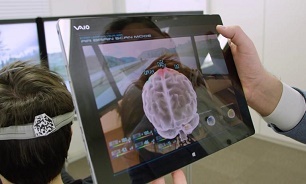Nissan Developing Brain-to-Vehicle Technology to Enhance Driving Experience
What if your car knew you were braking a few milliseconds before your foot pressed down on the brake?

Khodrocar - That possibility may become a reality in the next decade thanks to new technology being developed by Nissan that will enable vehicles to interpret brain signals from a driver that will speed up reaction times.
The new technology—dubbed Brain-to-Vehicle (B2V)—could lead to cars that adapt to the driver, to making the driving experience more enjoyable.
"What we built is a connection between our brain and the smart system in the vehicle,” Lucian Gheorghe, Ph.D., a senior innovation researcher at the Nissan Research Center in Japan, said in an interview with R&D Magazine. "In the future, developing smart systems is not done to replace the human being. We want to just increase the experience of the driver.”
For the system to work, the driver wears a helmet-like device that measure brain wave activity, which is then analyzed by an autonomous system.
The device has two primarily functions—using brain waves to decipher when the driver is about to make a driving action like braking and turning, and using brain waves to enhance the comfort of the driver by adjusting things like temperature control.
By catching signals that the user’s brain is about to initiate a movement, including turning the steering wheel, braking or pushing the accelerator, the technologies can begin the action quicker.
By anticipating intended movement, the systems can take actions—such as turning the steering wheel or slowing the car—0.2 to 0.5 seconds faster than the driver, while remaining largely imperceptible.
"We can start moving the tires before the steer by the driver,” Gheorghe said.
Other usages include the ability to adjust the vehicle’s internal environment, including adjusting what the driver sees and creating a more relaxing environment by changing the seat position or the temperature of the vehicle.
Gheorghe explained that the new technology could be used for both manual drivers and autonomous vehicles.
The system uses artificial intelligence to detect and evaluate driver discomfort, and changes to the driving configuration or driving style when in autonomous mode.
Nissan demonstrated the capabilities of the new technology at the CES 2018 trade show in Las Vegas, which is running from Jan. 9 to Jan. 12. The Japan-based company is using a driving simulator to demonstrate some elements of the technology at CES.
In a statement, Nissan Executive Vice President Daniele Schillaci explained that the purpose of the technology is to give more control to the driver in autonomous vehicles. The technology is designed to improve reaction times and enhance manual driving.
"When most people think about autonomous driving, they have a very impersonal vision of the future, where humans relinquish control to the machines,” Schillaci said. "Yet B2V technology does the opposite, by using signals from their own brain to make the drive even more exciting and enjoyable.
"Through Nissan Intelligent Mobility, we are moving people to a better world by delivering more autonomy, more electrification and more connectivity,” he added.
Gheorghe predicted that the technology could become commercially viable in five to 10 years.
source: RandDMagazine
The new technology—dubbed Brain-to-Vehicle (B2V)—could lead to cars that adapt to the driver, to making the driving experience more enjoyable.
"What we built is a connection between our brain and the smart system in the vehicle,” Lucian Gheorghe, Ph.D., a senior innovation researcher at the Nissan Research Center in Japan, said in an interview with R&D Magazine. "In the future, developing smart systems is not done to replace the human being. We want to just increase the experience of the driver.”
For the system to work, the driver wears a helmet-like device that measure brain wave activity, which is then analyzed by an autonomous system.
The device has two primarily functions—using brain waves to decipher when the driver is about to make a driving action like braking and turning, and using brain waves to enhance the comfort of the driver by adjusting things like temperature control.
By catching signals that the user’s brain is about to initiate a movement, including turning the steering wheel, braking or pushing the accelerator, the technologies can begin the action quicker.
By anticipating intended movement, the systems can take actions—such as turning the steering wheel or slowing the car—0.2 to 0.5 seconds faster than the driver, while remaining largely imperceptible.
"We can start moving the tires before the steer by the driver,” Gheorghe said.
Other usages include the ability to adjust the vehicle’s internal environment, including adjusting what the driver sees and creating a more relaxing environment by changing the seat position or the temperature of the vehicle.
Gheorghe explained that the new technology could be used for both manual drivers and autonomous vehicles.
The system uses artificial intelligence to detect and evaluate driver discomfort, and changes to the driving configuration or driving style when in autonomous mode.
Nissan demonstrated the capabilities of the new technology at the CES 2018 trade show in Las Vegas, which is running from Jan. 9 to Jan. 12. The Japan-based company is using a driving simulator to demonstrate some elements of the technology at CES.
In a statement, Nissan Executive Vice President Daniele Schillaci explained that the purpose of the technology is to give more control to the driver in autonomous vehicles. The technology is designed to improve reaction times and enhance manual driving.
"When most people think about autonomous driving, they have a very impersonal vision of the future, where humans relinquish control to the machines,” Schillaci said. "Yet B2V technology does the opposite, by using signals from their own brain to make the drive even more exciting and enjoyable.
"Through Nissan Intelligent Mobility, we are moving people to a better world by delivering more autonomy, more electrification and more connectivity,” he added.
Gheorghe predicted that the technology could become commercially viable in five to 10 years.
source: RandDMagazine
Latest News


